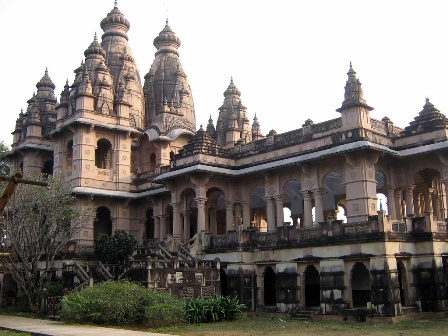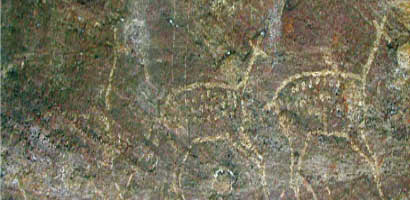


Historic Interest of Jharkhand

Copyright © visitindia.org.in 2011-12. All Rights Reserved.
More info on Jharkhand

People visit Jharkhand not just visit other places, but other times. The past is unbelievably attractive and authentic. If one seeks the cultural roots and the long traditions that bind past to present. This priceless heritage, that will never be remade or replicated nor altered. Every destination will be like a mythic deliverance for the traveller interested in history and archeology. Enchantment will go hand in hand with your journey into Jharkhand's past - a meeting ground, the common place of Indian history, a plural embracing of religious beliefs, a multitude of heroes, gods and goddesses, rubbing shoulders with the living, casting a benevolent eye on Jharkhand's progress into the future.
.
The enormous wealth of past times, civilized existence, human socities and their cultural patterns, survive in caves, monuments, rock-art in shelters (petrographs) and it is open for the world to explore. Cave paintings in some part of Jharkhand, 'stone art' and 'petrography' also indicate the passage of geological time and the ancient presence of a civilization that may even pre-date the legendary Harappa. Many districts of Jharkhand abound in such sites and relics.
Harzaribagh
To the north of Hazaribagh is Itkhori, around 16kms west of Chouparan. Here one can view the archeological remnants, the Maa Bhadrakali temple complex which is believed to have been built in the 9th century. People offer sacrifices in the form of animals and shave off their hair to appease the Goddess. The workmanship of the carved images and statues are worth seeing. The 1008 shiva lingams in the temple within the complex is a wonder in itself. 104 Bodhisattvas and 4 statues of Buddha are seen to be sculpted with precision and great beauty. A stone slab with the impression of Sheetalnath (The 10th Tirthankara of the Jain religion) is seen here. The Itkhori village otherwise a small town shows the unique blend of Hinduism, Buddhism and Jainisim. There are site of Buddhist relics dating from 200 BC to 1200 AD.
.
An abundance of fossil remains and pre-historic artifacts in some places of Jharkhand point out the possibility that the transformation of homo erectus to homo sapiens took place in the Chotanagpur region. Stone axes and other tools of early civilizations date back to over 3000 years. In the 6th or the 7th century BC - the era of the epic Mahabharata - the "Kikat" Pradesh mentioned in Rig Veda was located somewhere in the Parasnath hills in Giridih district of Jharkhand.

Naulakha temple
Satpahar is another site in Hazaribagh has rock paintings and can be called a beautiful rock art gallery in the entire world. The sandstone rocks have drawings of fishes, deers, cows, frogs, small animals like squirrels, insects like grasshoppers and so on. Many stone axes have also been found from these places. Cave paintings have been seen a bit far away, which falls nearby the Sati hills. The caves are large enough to have around 200 sitting people. .

The other side of the cave has a rivulet which has water flowing around the year. Ancient man have been living here, and the evidence suggests so, pictures of men and women with raised hands were also seen on one side of the cave. Another picture shows a group of men returning home after hunting carrying a dead animal. Probably they made the paintings after they had a good hunt.
Isko village located to the south east of Hazaribagh about 45 kms away also has rock paintings which has been dated to the mid stone age. Thsi gives evidence that human inhabitation was evident in the rocky plains of Jharkhand which lies between the Damodar river and the hills of the Chotanagpur plateau. The rock paintings are about 10,000 years old. Here to the subject are animals, men and women and gods and goddesses. Deep underground caves has also been found here in Isko which suggests that man lived underground in the Ice age. Pottery, tatoos, marriage, harvest paintings etc have been seen here. On the east west ridge of the Saptahar are three rock art sites. The naming as goes Saptahar1 has a etched bison and a deer with bandaged feet. Saptahar 2 has animals like bisons, tigers, langurs, buffalo and many x-ray kind of figures. Saptahar 3 has figures of spotted deers.
- Khandhar is around 3 kms away and it is the only spot where butterflies drawn as a subject of rock paintings have been seen.
- Badam - A village in Baekagaon which has 4 ancient temples of Lord Shiva apart from a fort.
- Barakatta - An ancient temple with stone sculptures.
- Banda - The Paleolithic age axes made of stone have been discovered.
- Bargunda - Copper utensils and tools have been found from this site.
- Karharbari - Copper some unfinished have been found here.
- Ramgarh - Tools from the stone age were discoverd here
Chatra
Jain & Buddhist relics have been found from many areas here. Cave paintings of the prehistoric period have been seen in Saraiya and Thetangi villages. Kalhua Pahari located on a hill which has an ancient Durga temple. Punkhri is the premier megalith site in Jharkhand. Nautangwa is a cave shelter which has figures of animal forms like that of a mother chasing her son. Sidpa has the figures of animals like bulls and deers, enroute Sidpa is a spot where there are stone blocks which has designs of Goddesses. Raham Cave was said to be the refuge for the Tana Bhagats in the 19th century.
Dhanbad
Dalmi or Diapur is on the banks of the Subarnarekha river and has the runis of many temples, also seen are the relics of some Buddhist statues. Katras is 16 kms away and a few statues have been found here. Gopalpur has an ancient pillar dating back to Emperor Ashoka. Panrra is a place where the Pandavas have been hiding during their exile, there is a temple of Lord Shiva here known as the 'Pandaveshwar Mahadeo'.
Ranchi
Deori is 3 kms away from Tamar in Ranchi and the place is quite famous for the temple of Silahbhuji devi. is 26 kms away and hasmany ruins of temples. Tilmi has the ruins of a fortress dating back to 1737 AD. Kairo is 16 kms away and here the palace of King Hiralal Nath Sahdeo is seen. There is a well here which never dries up and an old temple is also seen here. Chutia has the famous Radhaballah temple. Kunjla is 4 kms away from Khuti and iron objects as well as pottery made of clay have been found here. At Ranchi on top of the Ranchi hill is the Pahari Mandir - Shiva temple. But on Independence and Republic day the national flag is hoisted here, which is very unusual in temples. Many of the freedom fighters have been put to gallows here. After India got freedom the people here decided to pay their homage to the heroes here in this way.
Singhbhum (East & West)
Bahragora village has a temple where Lord Shiva is worshipped. Guhiapal tells us about the civilization of the banks of the river Subarnarekha as old as the 10th century. At Mayurbhanj ie the border of Orissa is Benusagar where there are some old temples and stone sculptures. Dalbhumgarh has the Kali mata temple and the place is also historically famous for the king Narsingh Rajbari who resisted the Bristish soilders with just 2000 supporters.
Sahebganj
A city built by Akbar in the 15th century is Rajmahal which was made the capital of Bengal by Raja Maan Singh. The Jami Masjid in Rajmahal is a mosque with a large prayer hall and was once considered the most beautiful building in Bengal. Nearby is Bara Darwaza which was once a fort, it has identical 12 doors and it is a heritage site declared by the Archeological Survey of India. Enroute Sahebjang is the Sangi Dalan. Here a marble palace built by Raja Maan Singh is seen. Ganges river flows by its side. In Kanhaiyasthat, which is in the Sahebganj district are foot impressions of Sri Sri Chaitanya Mahaprabhu, the saint. In Saranda are many temples and this place is called the land of 700 hills and has the beautiful Sal forests.
Palamau
Palamau is known to be the 'tiger country', because of its Betla National Park. The park has one of the earliest tiger reserves set up in 1974. Apart from the forest is the Betla fort which once belonged to the Chero kings. The Cheros believe to the descendents of the Chandravanshis or the moon legacy . This is a must visit place.